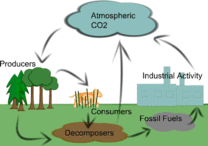- Southampton Middle School
- Biotic and Abiotic Cycles (L.S. 7)
Edwards, Stephen (Grade 8 Physical Science Teacher)
Page Navigation
-
Biotic and Abiotic Cycles Key Concepts

• In order to understand how an ecosystem functions, one must understand the concept of a system and be able to envision models of systems.
• To analyze the interactions resulting in a flow of energy and matter throughout the ecosystem, one must identify the elements of the system and interpret how energy and matter are used by each organism.
• Many important elements and compounds cycle through the living and nonliving components of the environment as a chain of events that continuously repeats.
• Energy enters an ecosystem through the process of photosynthesis and is p assed through the system as one organism eats and is, in turn, eaten.This energy flow can be modeled through relationships expressed in food webs.
• Materials are recycled and made available through the action of decomposers.
• The amount of energy available to each successive trophic level (producer, first-order consumer, second-order consumer, third-order consumer) decreases. T his can be modeled through an energy pyramid , in which the producers provide the broad base that supports the other interactions in the system.
-
Files and Documents
 Example Roles in Food Webs 1 (Matching)
Example Roles in Food Webs 1 (Matching)
 Example Roles in Food (Matching)
Example Roles in Food (Matching)
 Food Webs and Energy Pyramids (Challenge Board)
** Use HTML Mode
Food Webs and Energy Pyramids (Challenge Board)
** Use HTML Mode
 Carbon, Nitrogen, and Water Cycle
(Half a Minute)
Carbon, Nitrogen, and Water Cycle
(Half a Minute)
 Abiotic and Biotic Factors Comparison
Abiotic and Biotic Factors Comparison
 Ecology Groups and Abiotic/Biotic Comparison
Ecology Groups and Abiotic/Biotic Comparison
 Food Chain and Web Overview Notes
Food Chain and Web Overview Notes
 Meadow, Arctic, Pond Food Webs
Meadow, Arctic, Pond Food Webs
 Woodland, River, Seashore Food Webs
Woodland, River, Seashore Food Webs
 Roles in Food Webs: Austrailian Grassland, African Grassland, Antarctica, and Marine
Roles in Food Webs: Austrailian Grassland, African Grassland, Antarctica, and Marine

